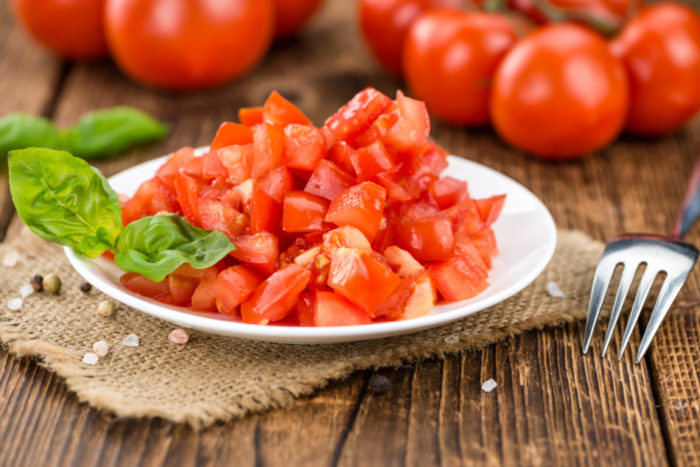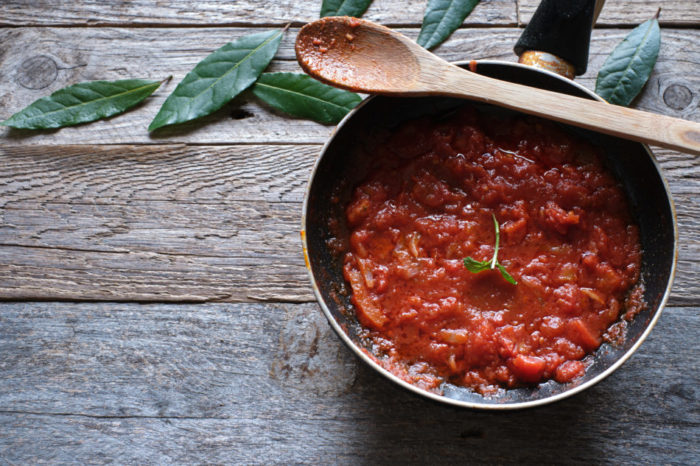You’ll encounter a diverse variety of canned tomatoes in the grocery stores. All types contain the same thing and yet they have slightly different tastes. Diced tomatoes are the most used form in them. These tomatoes add thickness, flavor, and body to the recipes.
But if you run out of diced tomatoes, there are alternatives you can use. Here’s a list of substitutes for diced tomatoes and a guide to how to use them.

Best Substitutes For Diced Tomatoes
To make diced tomatoes, tomatoes are peeled, cored, and seeded. They are then diced into symmetrical chunks and stored in tomato puree or tomato juice.
Calcium chloride or citric acid is used as a preservative. Due to this, the chunks remain slightly firm even after cooking. Also, diced tomatoes have a slightly cooked flavor.
So we need an alternative that could add body to the recipe like diced tomatoes. And it should also reciprocate the flavor.
1. Fresh Tomatoes
Fresh tomatoes are quite easy to work with and give a more fresh taste. So if you’ve got some at hand, go with them. Roma or San Marzano fit best but any type would do.
Diced tomatoes are peeled, seeded, and cored. So if you have time, steam the tomatoes until the skin loosens up. Then peel off the skin and quarter it. Remove the core and seeds and dice the quarters into the size you want.
These diced tomatoes will remain slightly firm if you don’t cook them too much. They’ll also have a mildly cooked flavor because of the steaming.
Use 2 cups of fresh tomatoes for every 14.5 oz can of diced tomatoes. Also, keep the juice from these fresh tomatoes for use. Since diced tomatoes are canned with tomato juice too, it’ll help maintain the same volume. This alternative can replace diced tomatoes in almost all recipes.
2. Crushed Tomatoes
Crushed tomatoes are a mixture of finely diced tomato chunks and tomato puree. So, though it won’t add much body to the recipe, it’ll give a similar texture and flavor. The tomatoes used here are also peeled, cored, and seeded, just like diced ones.
Use this alternative in equal amounts in recipes where you need texture and some volume. In a soup, it gives a fine but dense texture and the small chunks add to the volume.
You can also employ it in making sauces, lasagna, or pasta. If you want firm tomato chunks as in diced tomatoes, don’t cook it for long.
3. Tomato Puree
Use tomato puree in texture-based recipes. It is made by peeling tomatoes, then cooking them to reduce moisture content. It is then skimmed and strained to obtain a puree.
Some brands of canned tomato puree contain salt, sugar, and other added spices. So always check the labels before cooking to balance all the flavors.
One can of tomato puree replaces the same amount of diced tomatoes. Employ it in gravies, soups, stews, and sauces. It adds to the texture but lacks chunks as in diced tomatoes.
Unlike diced tomatoes, add tomato puree to the pan at the beginning. Although diced tomatoes get soggy if cooked for long, puree tastes best when cooked slow and long.
Read more: Need A Tomato Puree Substitute? Here Are Best Options
4. Tomato Sauce
Tomato sauce is very distinct from diced tomatoes. So you might wonder if you could substitute tomato sauce for diced tomatoes. You can, but not in all recipes. Tomato sauce is processed and has many added ingredients.
So use it only in the recipes that could go with a mixture of flavors. You can try making meatballs, stews, gravies, and pasta sauce.
Tomato sauce has a flowy consistency. So first you’ll need to cook it to reduce its volume and thicken it. Use 6 to 10 tablespoons of tomato sauce in place of one can of diced tomatoes.
5. Whole Peeled Tomatoes
Among all forms of canned tomatoes, the whole peeled ones have the most similar flavor to diced tomatoes.
As the name suggests, it includes whole tomatoes whose skin has been peeled off after steaming. It is stored in tomato juice in the can. The steaming process adds a similar cooked flavor to it.
However, since the tomatoes are whole, you’ll need to seed and core them. For that, quarter the whole pieces and remove the seeds and core. Then dice the quarters into the desired size. If you want, you can keep the seeds and core too.
The diced chunks obtained here aren’t as firm as diced tomatoes. So don’t cook them for long if you want to keep some solid chunks in your recipe. Also, keep the juice that seeps from the tomatoes while you cut it. This will make up for the overall volume.
If you’ve got time, simmer the tomato chunks and juice for a few minutes. This will allow the mixture to thicken and will add a similar texture to the dish as diced tomatoes. Use this alternative when making pasta, ravioli, meat, or soups.
6. Tomato Juice
You can either buy tomato juice from the market or make it at home. Just take some fresh or whole peeled tomatoes, remove their seed and pulp, then dice them. Then put the chunks in the blender.
Keep the seeds and pulp if you prefer. Since the juice has a flowy consistency, you can thicken it by simmering. Although the taste and texture here will differ from diced tomatoes, the juice acts as a nice substitute in some recipes.
If you’re buying tomato juice, make sure to check the label for ingredients. Some brands have added salt and spices, so you’ll need to balance the flavors.
Tomato juice is slightly acidic. So it tenderizes the meat, poultry, or fish recipes. You can also use it in broths or braises.
Top Substitute For Crushed Tomatoes

1. Tomato Paste
Tomato paste is a concentrated product that can come in handy for almost all tomato-product replacements. It’s thick, pure, and generally made from fresh tomatoes. The consistency here will be remarkably similar to that of crushed tomatoes, so using it as a replacement becomes easier.
Don’t like how thick the paste is? Add some water! Alternatively, mix-in some fresh or diced tomatoes and blend that mixture. The paste is easily available and very versatile. In most cases, you can use a 1:1 replacement for crushed tomatoes.
2. Tomato Sauce And Tomato Paste Combo
Tomato sauce can work as a replacement for crushed tomatoes, but it doesn’t quite have the same results. It’s pretty much a choice of last resort. But there is a way to make it better, and we’ve already been introduced to it – tomato paste!
Blend tomato sauce and tomato paste together and you’ve got a somewhat decent solution. The combo makes the sauce get a better consistency. In the same vein, the tomato paste gives up being highly concentrated and the combination acquires a better flavor.
3. Pizza Sauce
Is this an ideal solution? No, but it can be a fairly decent option depending on your choice of recipe. Pizza sauce is made from crushed tomatoes, along with other ingredients like herbs and spices. So, it can be an acceptable replacement for some recipes, especially if you thicken it up a bit with tomato paste.
4. Condensed Tomato Soup
This one seems a bit out there, but condensed tomato soup can get the work done. Well, at the very least, it’s better than having no alternative at all. Okay, that doesn’t sound very encouraging, but we can accept it for some options.
The soup is thick and full of flavor. You might want to add some water to get a better consistency and mix it well. Things can go awry if the soup has a strong flavor, but perhaps it can work for some savory recipes.
5. Marinara Sauce
Marinara sauce is a cousin of pizza sauce. While the latter is made from crushed tomatoes, marinara sauce uses whole tomatoes that have been peeled. Pizza sauce has a thicker consistency, so some changes are necessary to marinara sauce before it can replace crushed tomatoes. The easiest choice here, again, is to add some tomato paste to thicken up the marinara sauce.
How To Use Diced Tomatoes In Your Recipes?
Diced tomatoes work best in recipes that are simmered and cooked for longer periods. The preservatives used for canning keep the chunks firm and they retain the firmness even when cooked.
These chunks along with the tomato juice or puree add a tangy and slightly cooked flavor to the meals. Also, the longer you cook it, the denser texture it gives to the recipes.
Canned diced tomatoes are most popular in Italian-American cuisine. Use it when preparing tacos, sauces, soups, Italian sausages, or gnocchi. It also adds delicious flavors to casseroles, seafood, salsa, braised chicken, and can be used as dips
Diced vs Crushed Tomatoes
There is a small but significant difference between diced vs crushed tomatoes. Generally, both of these are canned products that one could buy from the market.
Diced tomatoes are cut tomatoes or tomato chunks placed in tomato juice. Often, citric acid and calcium chloride will be used as preservatives. These help the diced tomatoes retain their shape and stay firm.
Crushed tomatoes represent small tomato chunks in tomato puree. Both these products look quite similar, but the diced tomatoes have firmer and larger chunks. These chunks will take a while to soften and are best suited for dishes that cook for a long time..
Which Alternatives Are Best For Use?
If you’re preparing gravies, soups, or stews, fresh tomatoes or tomato puree would be the best choice. You can go for tomato sauce if you need a more complex taste along with the tomato flavor.
If you want to replicate the flavor of diced tomatoes, whole peeled tomatoes would be the best option for you. And use tomato juice when preparing meat or poultry recipes.
All these canned or homemade alternatives can replace diced tomatoes in one recipe or the other. Consider what goes best with your dish to choose the right substitute for diced tomatoes for you.